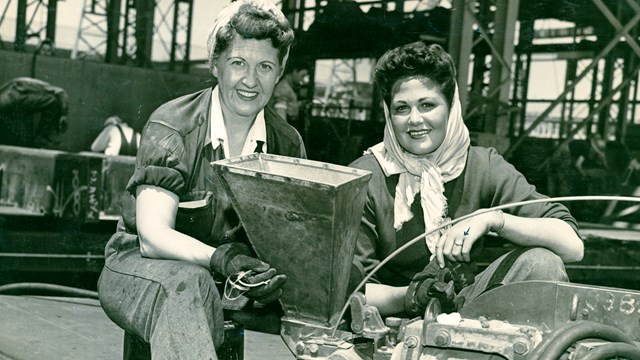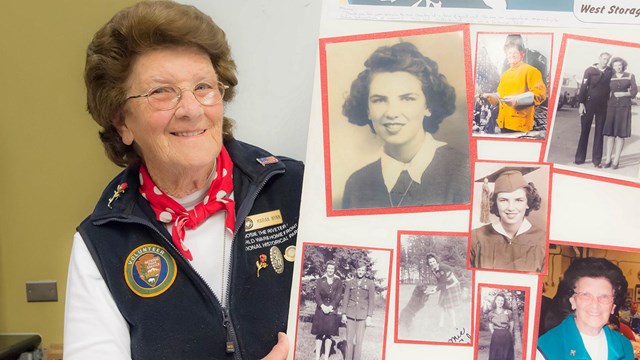
Sites To See!
The Richmond Home Front provides a number of historic places to drive by, view or visit. Click the image for points of interest. 
History and Culture
Looking to learn more about the WWII Home Front? Start by clicking here. 
People
Learn more about the people that are an important part of the Home Front Story. Urban Growth and Housing Struggles in Richmond During World War IIRichmond's Housing Crisis As thousands of workers streamed into Richmond, both public and private entities struggled to keep the city’s burgeoning population housed, healthy, and highly productive. The influx caused intense strain on city infrastructure, particularly in housing. Workers arriving in these rapidly expanding urban centers were forced to live wherever they could find space. Most defense housing consisted of large barrack-type apartment buildings or single-sex dormitories. Even these modest quarters were treasured since the housing shortage led many workers to live in tents, boats, and cars, and share “hot beds” on a rotating 8-hour schedule. To address this crisis, Richmond embarked on a significant federal housing initiative, resulting in the construction of more than 21,000 public housing units by 1943. These developments, which housed over 60% of Richmond's population at the time, represented the largest federal housing program in the nation by the war's end. Early projects included well-planned complexes like Atchison and Nystrom Villages, strategically located near the shipyards to facilitate worker access. Despite these efforts, racial segregation persisted within Richmond's housing policies. The Richmond Housing Authority implemented discriminatory practices that restricted access to the better-quality housing units, like those in Atchison and Nystrom Villages, to white upper-level workers and management. This exclusionary approach marginalized African American migrants, who often settled in North Richmond, an unincorporated area where housing options were more available. The discriminatory housing practices prompted a response from Richmond's African American community. In 1944, amidst mounting frustrations, a local chapter of the NAACP was established. This organization played a pivotal role in advocating for housing equity and challenging segregationist policies within the city. Their efforts were part of a broader struggle for civil rights and social justice during a transformative period in Richmond's history. Healthcare, Childcare, & EducationDuring World War II, the Kaiser shipyards in Richmond led pioneering efforts to address the social needs of their workforce and families, setting new standards in healthcare, childcare, and education driven by wartime demands. The shipyards supported unprecedented social programs in healthcare and childcare, alongside the rapid development of affordable housing and childcare centers in Richmond. Kaiser Permanente, one of the nation's first voluntary, prepaid medical plans, was established in 1942 to provide comprehensive healthcare for shipyard workers in Richmond and Vanport, Oregon. This innovative health system included first-aid stations, a field hospital, and a main hospital, delivering prepaid medical care—a visionary model that laid the foundation for today's Kaiser Permanente health system. Federal funds facilitated the creation of approximately 35 childcare centers across Richmond, supporting preschool childcare for women working in the shipyards. At its peak, with around 24,500 women on the Kaiser payroll, Richmond’s citywide childcare program served approximately 1,400 preschool children daily. Some centers offered 24-hour care to accommodate mothers on night shifts, providing balanced meals, healthcare, and optional family counseling. These initiatives not only met critical wartime needs but also served as models for social progress, demonstrating what could be achieved in times of crisis and inspiring ongoing advancements in peacetime. They underscored the importance of comprehensive support systems for workers and their families, leaving a lasting legacy of innovation and community resilience in Richmond's history. Atchison VillageA Historic Model of Worker Housing and Community Planning Named for its proximity to the Atchison, Topeka, and Santa Fe Railroad station and yards, Atchison Village stands as a reflection of innovative community planning during World War II. Built in 1941 by the U.S. government to house workers for the newly established Kaiser shipyards, this 450-unit complex was a pioneering example of worker housing. It was designed with winding streets that promoted a sense of space and community, spacious yards for residents, and simple yet functional wood duplexes and fourplexes. Central to Atchison Village's design was the inclusion of a community center and park, fostering social interaction and recreational opportunities for its residents. This integrated approach aimed to support the well-being and productivity of the workforce during wartime. Today, Atchison Village remains a thriving planned community that continues to embody its original principles of community living. It is seamlessly integrated into the surrounding parklands, blending residential comfort with natural surroundings. The neighborhood is now marked by a park entrance sign that welcomes visitors to explore its historic and livable environment. Nystrom VillagePreserving History and Community Nystrom Village occupies a strategic location spanning Maine, Virginia, and Florida Avenues between 13th and 16th Streets in Richmond. This housing development comprises 51 single-story duplexes organized around central open spaces, echoing the design principles seen in Atchison Village, the only other remaining defense housing project in the vicinity. Originally constructed to accommodate the workforce of the Kaiser shipyards during World War II, Nystrom Village continues to serve the community today. The complex features one-, two-, and three-bedroom units, which have been maintained largely intact and are currently managed as low-income housing by the Richmond Housing Authority. Looking forward, there are plans to repurpose one of the houses into an exhibit showcasing daily wartime home life, offering visitors insight into the historical context of the village and its role during the war effort. Nystrom Village stands as a tangible reminder of Richmond's wartime industrial history and its ongoing commitment to affordable housing and community preservation. Nystrom SchoolDuring World War II, Nystrom School, along with Pullman, Lincoln, and Stege Schools, faced severe overcrowding due to their proximity to defense housing projects. The influx of new students from these housing areas strained the existing educational infrastructure. To address this issue, Nystrom School underwent significant construction, tripling its number of classrooms. Despite this effort, funding constraints prevented similar expansions at other schools in the district. As a result, many Richmond schools resorted to holding double and even triple daily sessions to accommodate the burgeoning student population. By 1944, only sixty additional classrooms had been built across the district. This led to an average elementary school enrollment of sixty-seven children per classroom, significantly higher than the ideal student-to-teacher ratio. The efforts to manage the overcrowding at Nystrom School highlight the broader challenges faced by educational institutions in rapidly growing urban areas during wartime. Maritime Childhood Development CenterThe Maritime Childhood Development Center, established during World War II in Richmond, California, was a cornerstone of support for families of workers employed at the Kaiser shipyards. This center exemplified a pioneering approach to childcare and family support, crucial for maintaining the productivity of the wartime workforce.Strategically located near the shipyards, the center catered specifically to the children of shipyard workers, offering a safe and nurturing environment. It provided not only childcare but also preschool education, ensuring early childhood development was prioritized amidst the demands of war. The center operated with federal support and played a vital role in enabling mothers to participate in the workforce by offering services such as 24-hour childcare to accommodate night shifts, nutritious meals, healthcare access, and optional family counseling. The establishment of the Maritime Childhood Development Center underscored the community's commitment to holistic support for its residents during a time of national crisis. Its innovative model set a precedent for future childcare initiatives and highlighted the importance of comprehensive family services in sustaining industrial productivity and community well-being during wartime. Key Facts About Richmond's WWII Housing and Education InitiativesAtchison Village
Nystrom Village
Nystrom School
Maritime Child Development Center
Housing and Population Growth
Discriminatory Housing Practices
|
Last updated: August 6, 2024
